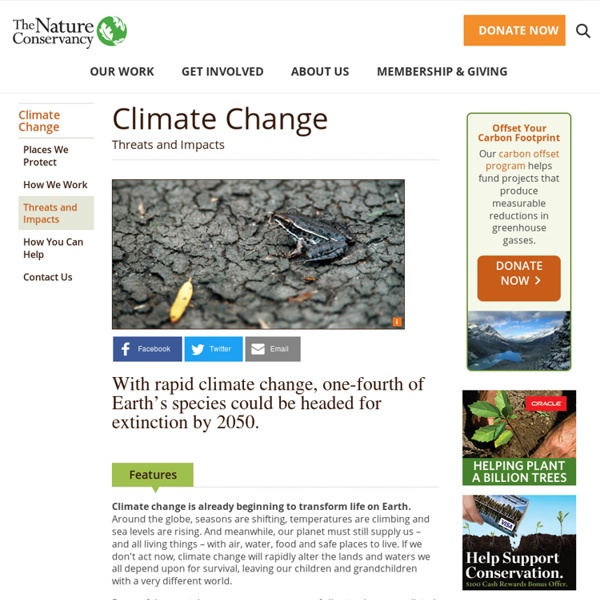



Las tormentas solares Las tormentas solares se producen cuando el ciclo solar alcanza su máxima actividad y justo después. Es decir, cuando la actividad magnética del Sol es más fuerte y comienza a descender. Hay un máximo solar cada 11 años. El último comenzó a finales del año 2.012 y se prolongó durante el 2.013. Las tormentas solares consisten en violentas explosiones de plasma y de partículas cargadas, llamadas fulguraciones y, sobre todo, eyecciones de masa coronal. La actividad magnética del Sol hace que se formen bucles de plasma en su superficie. Durante una tormenta solar, se expulsan y se expanden por todo el Sistema Solar millones de toneladas de plasma y partículas cargadas, junto con gran cantidad de rayos X y gamma, la radiación más potente que existe. Las partículas cargadas tardan en alcanzarnos de uno a tres días, aunque a veces llegan en sólo unas horas. Aún no es posible predecir cuándo se producirá una tormenta solar.
Effects Global climate change has already had observable effects on the environment. Glaciers have shrunk, ice on rivers and lakes is breaking up earlier, plant and animal ranges have shifted and trees are flowering sooner. Effects that scientists had predicted in the past would result from global climate change are now occurring: loss of sea ice, accelerated sea level rise and longer, more intense heat waves. Taken as a whole, the range of published evidence indicates that the net damage costs of climate change are likely to be significant and to increase over time. Scientists have high confidence that global temperatures will continue to rise for decades to come, largely due to greenhouse gases produced by human activities. According to the IPCC, the extent of climate change effects on individual regions will vary over time and with the ability of different societal and environmental systems to mitigate or adapt to change. Future effects Change will continue through this century and beyond
Expedition | A Student's Guide to Global Climate Change Get your passport ready! It's time to go on a trip around to world to explore the effects of climate change. Each flag on the map below represents a stop on your journey, and you can visit them in any order you like. You'll see a short video at each stop... and you'll also need to complete a few challenges along the way! Accessible version for screen reader user Before you begin... (<a href="expedition-popup-alt.html">Alternative version</a>) <a href="expeditions-508.html">Accessible version of all the expeditions</a> Map Data Imagery ©2015 NASA Satellite Map Select any flag on the map to start your journey! At the end of each stop, you'll get a passport stamp and a code. How Does this Expedition Work? At each stop on your journey, you'll see a 5– to 10–minute video. Depending on your Internet connection speed, the video might pause occasionally to allow the rest of the file to download. Each video will pause a few times to ask you a question. Enter your codes on the tracking sheet.
Sist solar 2 Climate change: the effects on ocean animals The “poster child” for global warming is the polar bear. But many other animals are already feeling the effects of global climate change on the oceans. Find out about the changing climate's impact on the earth’s population of sea turtles, right whales, penguins, seals, lobsters, and cod. The Arctic’s top predator, the polar bear, is affected both by the reduction in sea ice and by reduced stocks of its primary food, the ringed seal. Polar bears use sea ice as a platform for hunting their prey and for resting. But sea ice is decreasing throughout their Arctic range due to climate change. As sea ice becomes thinner and multi-year ice disappears, a greater proportion of females make their dens on land, expending more energy to get there. Polar bears are often described as completely dependent on ice for their survival. In 2008, the U.S. Back to top Taken by New England Aquarium Educator Jessica Lavash in Padre Island, Texas. Adult feeding patterns are also affected by climate change.
Global Warming Effects Map - Effects of Global Warming Sist solar Climate Change | Island Institute A Climate of Change Workshop | Ocean Acidification Island and coastal communities are on the front line of environmental changes associated with climate change and ocean acidification. Across New England, fishermen and scientists are observing notable shifts in the ecosystem and dramatic changes in the number of fish in the water. Years of harvesting pressure paired with the effects of warming waters and an ever-changing ocean ecosystem have led to the crisis we currently face in the groundfish fishery. Other fisheries such as lobster and shrimp are also grappling with shifting environmental conditions. Scientists, managers, and fishermen have all begun to discuss how we can and should be planning for the unpredictable, impacts these shifts will have on the marine environment and the communities that depend on the ocean resources. We do this by: A Climate of Change Workshop View the full Climate of Change Workshop Report Video Series Part 1: Warming Waters in the Gulf of Maine